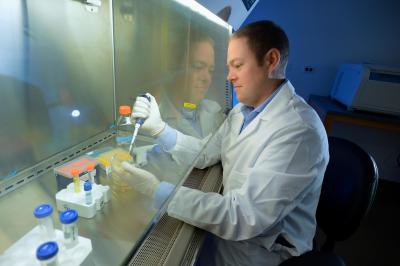The best defense is a good offense, especially when it comes to the immune system. The troops that respond to an infection are split into two squadrons, and, until recently, it seemed that the two were independent, without much interaction.
Now, in a paper published this week in Nature Immunology, a team of scientists from the Virginia Tech Carilion Research Institute and the University of Alabama at Birmingham say that the immunology boot camp is more communication-intensive than initially thought — a discovery that could help efforts to produce more effective vaccines.
“We have two populations of T cells,” said Kenneth Oestreich, an assistant professor at the Virginia Tech Carilion Research Institute, referring to the immune system squadrons. “Before this study, we didn’t know if the types of cells were entirely separate, or if they could transition into one another. Now, this study suggests that memory cells may arise directly from the effector cell population.”
In this case, memory cells are not the ones in the brain helping people recall facts.
These cells work in the body’s immune system and retain information about threats from invaders, allowing the body’s natural defenders to mount a quick, more powerful response if the same threat is encountered again.
The T cells – white blood cells – break down into the two groups as a part of the adaptive immune system, and they’re programmed to respond when a pathogen enters the body.
One squadron, composed of effector cells that release large volumes of antibodies, goes in with guns blazing to destroy the enemy. In the process, they release a lot of energy while metabolizing glucose – referred to as glycolytic activity.
The memory cells that make up the other group are stealthy. Sleeper cells, they gather information to prepare the body for the next battle against this type of pathogen. They use far less energy and, as a result, have a much smaller glycolytic signature.
In addition to infections, vaccines also cause the body to produce memory cells, ready to join the war effort if a full-force infection invades.
The effector cell and memory cell groups have always appeared as independent populations, but scientists saw something intriguing in this most recent study.
“Our data suggest that the memory cell is actually a transitioning effector cell that has slowed its glycolytic programming,” said Oestreich, who is also an assistant professor of biomedical sciences and pathobiology in the Virginia-Maryland Regional College of Veterinary Medicine.
All cells, including effector and memory cells, are copied from DNA templates and proliferate in the body.
In this transcription process, two proteins – T-bet and Bcl-6 – play major roles. T-bet is highly expressed in the effector cells, with a small amount of Bcl-6, while the opposite is true in memory cells, where Bcl-6 expression exceeds that of T-bet.
“Mechanistically, we figured out that these two factors, T-bet and Bcl-6, functionally interact,” Oestreich said. “T-bet antagonizes Bcl-6’s function.”
When an infection invades the body, the immune system increases the presence of interleukin-2, a molecule that signals the need for white blood cells to begin fighting. With high interleukin-2 levels, T-bet floods the system. As the infection and interleukin-2 wane, Bcl-6 levels increase. Oestreich and his team found that the excess Bcl-6 binds to genes involved in glycolytic programming, effectively shutting down the effector cells’ activity.
“The Bcl-6 influx is what leads the cell down the memory pathway,” Oestreich said. “The Bcl-6 factor targets and turns off the high-energy-producing signals and induces the memory profile.”
This research started in the laboratory of Amy Weinmann, then a professor at the University of Washington, and continued when Weinmann relocated her laboratory to the University of Alabama at Birmingham, while Oestreich started his own laboratory at the Virginia Tech Carilion Research Institute.
Oestreich’s team also continued this research, and they plan to determine how this information can be used to improve vaccine efficacy.
By studying the exact targets of Bcl-6, Oestreich says, researchers can understand how memory cell formation occurs naturally, which will allow for more therapeutic options to bolster the immune system.
“Your memory cells are there to detect recurring pathogens and eliminate them before you even suspect you’re ill,” Oestreich said. “If we could push the immune system to become that much stronger, we may be able to create better vaccines.”



